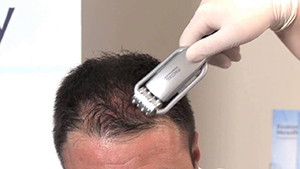
Mesotherapy
What is mesotherapy?
Mesotherapy is a technique that uses injections of vitamins, enzymes, hormones, and plant extracts to rejuvenate and tighten skin, as well as remove excess fat.
Michel Pistor, a doctor in France, developed the technique in 1952. It was originally used to relieve pain. In the years since, it has gained popularity in the United States and other parts of the world.

- Remove fat in areas like the stomach, thighs, buttocks, hips, legs, arms, and face
- Reduce cellulite
- Fade wrinkles and lines
- Tighten loose skin
- Recontour the body
- Lighten pigmented skin
- Treat alopecia, a condition that causes hair loss
The technique uses very fine needles to deliver a series of injections into the middle layer (mesoderm) of skin. The idea behind mesotherapy is that it corrects underlying issues like poor circulation and inflammation that cause skin damage.
There isn’t a standard formula for the substances injected in mesotherapy. Doctors use many different solutions, including:
prescription medicines like vasodilators and antibiotics hormones such as calcitonin and thyroxin enzymes like collagenase and hyaluronidase herbal extracts vitamins and minerals
How much does it cost?
The cost of mesotherapy depends on the type of treatment you’re getting and the number of sessions you need. In general, a single session costs between 3000 to 5000. Because mesotherapy is cosmetic and not medically necessary, insurance companies usually don’t cover the cost.


How do you prepare?
You’ll meet with the doctor ahead of time to find out what to expect. You might have to avoid aspirin (Bufferin) and other nonsteroidal anti-inflammatory drugs (NSAIDs) for one week before the procedure. These pain relievers can increase your risk of bleeding and bruising during mesotherapy.
What happens during your appointment?
During each session, you may or may not have numbing medicine applied to your skin. You’ll get a series of injections using a special short needle. The needle may be attached to a mechanical gun to deliver many injections in a row.
The injections can be given at different depths — from 1 to 4 millimeters into your skin — depending on what condition you’re having treated. Your doctor may place the needle into your skin at an angle, or flick their wrist very quickly while injecting. Each injection may only place a tiny drop of the solution into your skin.
You’ll probably need several mesotherapy sessions to get the desired effect. You should expect to return to the doctor between 3 to 15 times. At first, you’ll get the injections every 7 to 10 days. If your skin starts to improve, the treatments will be stretched out to once every two weeks or once a month.
How effective is the procedure?
It’s hard to say whether mesotherapy works, because so many different ingredients and methods are used in the treatment. Few studies have been done to test the technique. And many of the studies that have been done were small.
Many insurance plans consider PRP for hair loss treatment to be “cosmetic” and don’t cover any of the costs of the treatment. Check with your insurance provider to see if PRP therapy is covered for you.
How does it compare to liposuction?
Mesotherapy is considered a nonsurgical alternative to liposuction for removing unwanted fat.
Liposuction permanently removes fat from areas like your stomach, thighs, and back. Cosmetic surgeons perform this procedure by inserting a thin plastic tube through small incisions in your skin, and then suctioning out the fat using a surgical vacuum. Liposuction is done while you’re under anesthesia.
Although liposuction is considered effective at permanently removing fat, recovery can take up to six weeks. It also has risks like nerve and blood vessel damage, irregular skin contours.
It’s not clear how well mesotherapy works to remove fat. There hasn’t been enough research done to test it, and the methods that are used differ depending on where you have it done.
Injection lipolysis is another noninvasive treatment that’s similar to mesotherapy. The terms “mesotherapy” and “injection lipolysis” are often used synonymously, though they’re slightly different.
During injection lipolysis, your doctor injects phosphatidylcholine and deoxycholate into the fat layer under the skin to break up fat. As with mesotherapy, there is very little evidence to show injection lipolysis works.
What are the side effects and risks?
People who practice mesotherapy say the risks are minimal if you go to a trained practitioner.
Side effects that have been reported include:
Although liposuction is considered effective at permanently removing fat, recovery can take up to six weeks. It also has risks like nerve and blood vessel damage, irregular skin contours.
It’s not clear how well mesotherapy works to remove fat. There hasn’t been enough research done to test it, and the methods that are used differ depending on where you have it done.
Injection lipolysis is another noninvasive treatment that’s similar to mesotherapy. The terms “mesotherapy” and “injection lipolysis” are often used synonymously, though they’re slightly different.
During injection lipolysis, your doctor injects phosphatidylcholine and deoxycholate into the fat layer under the skin to break up fat. As with mesotherapy, there is very little evidence to show injection lipolysis works.




